LINGUISTIC 3 : Identity and interaction: a sociocultural linguistic approach
Title and Identity :
Identity and interaction: a sociocultural linguistic approach
Discourse Studies Copyright © 2005 SAGE Publications. (London, Thousand Oaks, MARY BUCHOLTZ UNIVERSITY OF CALIFORNIA, SANTA BARBARA CA and New Delhi) www.sagepublications.com Vol 7(4–5): 585–614. KIRA HALL 10.1177/1461445605054407UNIVERSITY OF COLORADO
Review :
In this article, reseacher propose a framework for the analysis of identity as constituted in linguistic interaction. The need for such a framework has become apparent in recent years, as linguistic research on identity has become increasingly central within sociolinguistics, linguistic anthropology, discourse analysis, and social psychology. Reseacher believe that the approach was propose here, which draws together insights from a variety of fields and theorists, allows for a discussion of identity that permits researchers to articulate theoretical assumptions about identity often left implicit in scholarship, while avoiding the critiques of this concept that have arisen in the social sciences and humanities in the past two decades. The first principle that informs our perspective addresses a traditional scholarly view of identity as housed primarily within an individual mind, so that the only possible relationship between identity and language use is for language to reflect an individual’s internal mental state. The second principle challenges another widely circulating view of identity, that it is simply a collection of broad social categories. This perspective is found most often in the quantitative social sciences, which correlate social behavior with macro identity categories such as age, gender, and social class. Within socio- cultural linguistics, the concern with identities as broader social structures is particularly characteristic of early variationist sociolinguistics and the sociology of language. While the first two principles we have discussed characterize the ontological status of identity, the third principle is concerned with the mechanism whereby identity is constituted. This mechanism, known as indexicality, is fundamental to the way in which linguistic forms are used to construct identity positions. In its most basic sense, an index is a linguistic form that depends on the interactional context for its meaning, such as the first-person pronoun I. Less direct means of instantiating identities include such pragmatic processes as implicature and presupposition, both of which require additional inferential work for interpretation. Different research traditions within sociocultural linguistics have particular strengths in analyzing the varied dimensions of identity outlined in this article. The method of analysis selected by the researcher makes salient which aspect of identity comes into view, and such 'partial accounts' contribute to the broader understanding of identity that we advocate here. Scholars of language use are particularly well equipped to provide an empirically viable account of the complexities of identity as a social, cultural, and – most fundamentally – interactional phenomenon.
Read full Article : Klik here






0 komentar:
Posting Komentar